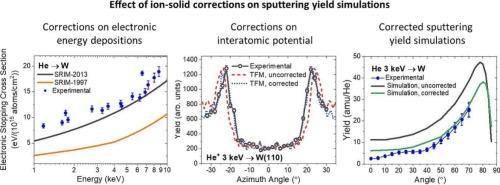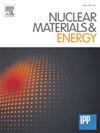光离子与等离子体表面材料的相互作用:提高实验精度及其对溅射良率模拟的影响
IF 2.7
2区 物理与天体物理
Q1 NUCLEAR SCIENCE & TECHNOLOGY
引用次数: 0
摘要
本文研究了描述离子-固体相互作用的基本参数的修正如何影响基于二元碰撞近似的溅射良率模拟。我们回顾了最近对等离子体材料候选体(W, Fe, EUROFER97)中光等离子体种(H, D, He)的电子停止功率和短程排斥原子间势的实验评估,并将它们与广泛使用的半经验模型和理论模型进行了比较。在低能量下,相对于SRIM-2013的差异高达60%,相对于SRIM-1997的差异高达210%,这表明需要改进输入参数。我们使用SDTrimSP模拟评估了溅射产量对这些修正的敏感性,并将结果与在高灵敏度石英晶体微天平上重新沉积的W, Fe和EUROFER97薄膜的新实验溅射产量数据进行了比较。将导出的停止功率和原子间势结合到模拟中,大大减少了实验和模拟溅射产量之间的差异。讨论了晶体结构效应和离子注入等剩余的不确定性和模型局限性。本文章由计算机程序翻译,如有差异,请以英文原文为准。

Interaction of light ions with plasma-facing materials: Improved experimental accuracy and its impact on sputter yield simulations
This work investigates how corrections to fundamental parameters describing ion–solid interaction affect sputtering yield simulations based on the binary collision approximation. We review recent experimental assessments of electronic stopping power and short-range repulsive interatomic potentials for light plasma species (H, D, He) in plasma-facing material candidates (W, Fe, EUROFER97), and compare them to widely used semi-empirical and theoretical models. At low energies, discrepancies of up to 60% relative to SRIM-2013 and up to 210% relative to SRIM-1997 are identified for the specific energy loss, highlighting the need for improved input parameters. We assess the sensitivity of sputtering yields to these corrections using SDTrimSP simulations, and compare the results to new experimental sputter yield data obtained for re-deposited thin W, Fe, and EUROFER97 films on a high-sensitivity quartz crystal microbalance. Incorporating derived stopping powers and interatomic potentials into the simulation significantly reduces the discrepancies between experimental and simulated sputtering yields. Remaining uncertainties and model limitations, such as crystal structure effects and ion implantation, are discussed.
求助全文
通过发布文献求助,成功后即可免费获取论文全文。
去求助
来源期刊

Nuclear Materials and Energy
Materials Science-Materials Science (miscellaneous)
CiteScore
3.70
自引率
15.40%
发文量
175
审稿时长
20 weeks
期刊介绍:
The open-access journal Nuclear Materials and Energy is devoted to the growing field of research for material application in the production of nuclear energy. Nuclear Materials and Energy publishes original research articles of up to 6 pages in length.
 求助内容:
求助内容: 应助结果提醒方式:
应助结果提醒方式:


